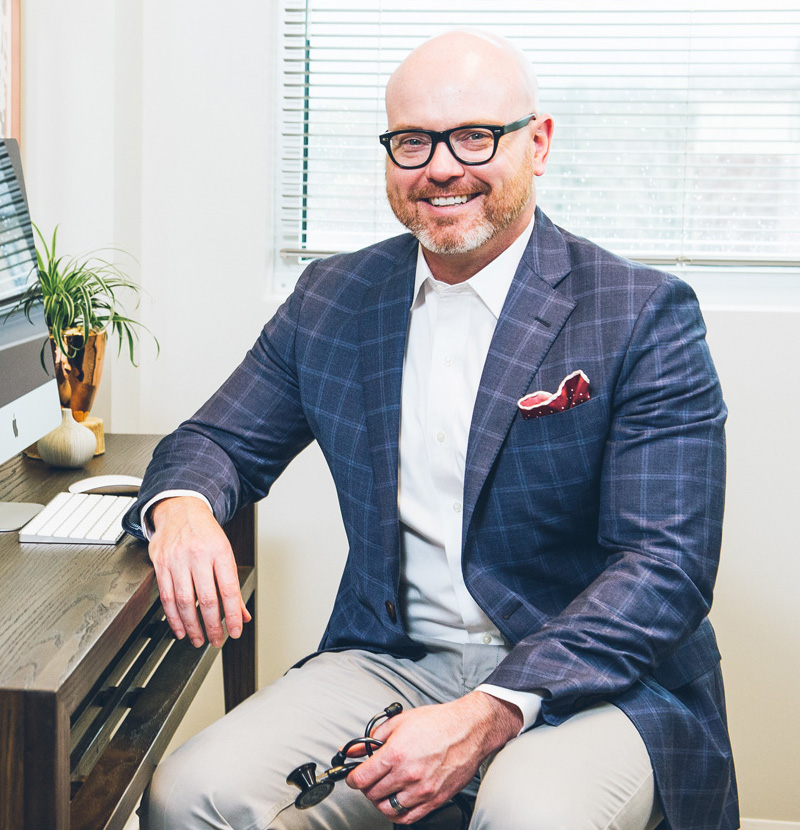Is our healthcare system working for us, or is it keeping us trapped in a cycle of illness? Diabetes, cancer, and cardiovascular disease account for 70% of deaths in our country, yet it’s easier to get medication to treat conditions than it is to prevent and reverse them! In the backwards mentality of our current medical culture, we treat disease instead of stopping it.
Chiropractic care represents the exception to this rule with its focus on holistic self healing. A dear friend of mine, Dr. Ronson Dykstra, has joined me to do what traditional physicians and doctors of chiropractic rarely have the opportunity to do: discuss the candid potential of chiropractic care.
Dr. Dykstra has been practicing chiropractic for 16 years in Franklin, Tennessee. His deep passion for prevention and self healing has helped Dr. Dykstra touch and transform the lives of his patients.
So why is only 10% of the population taking advantage of chiropractic care and its many benefits? Dr. Dykstra helps us breakdown the role of chiropractic in our current medical system and identify why it has become so misunderstood.
The Origins of Chiropractic Care
Dr. Dykstra is passionate and committed to the practice of chiropractic care, but this wasn’t a path he always meant to take.
“As a kid, I grew up in the traditional model of healthcare. I really never understood what chiropractic was. I didn’t know anything about it.”
After exploring a nomination to the Naval Academy and considering a career as an engineer, Dr. Dykstra returned home to help his father deal with back-related health issues.
He accompanied his father to chiropractor appointments and, as Dr. Dykstra explains, “I watched my dad start to have freedom from these old injuries that he’d been battling for years and years and years. And I thought it was the neatest thing.”
Witnessing his own father’s success with chiropractic care ignited a fire inside of Dr. Dykstra to help others the same way. He ultimately attended Palmer College in Devonport, Iowa, where the entire profession of chiropractic care originated in 1895.
Shortly before the turn of the 20th century, a janitor asked Dr. Daniel David Palmer to adjust his back after an injury. With just one single adjustment to a misplaced vertebra in the upper back, Dr. Palmer relieved the janitor’s back pain and restored hearing, which the janitor had lost 17 years before.
“It’s almost one of those stories where you’re like, come on, this isn’t a real story!” Dr. Dykstra jokes.
But the story is indeed true, and it marks the beginning of chiropractic care as we know it today.
Chiropractic Work Vs Standard Care
Dr. Daniel David Palmer knew that chiropractic techniques had been used for thousands of years, but they were never formalized with scientific proof. This inspired him to establish the Palmer College of Chiropractic in 1897.
Palmer applied his comprehensive knowledge of physiology and anatomy to the art and science of chiropractic care. His new college gave Palmer a platform to share his findings with others.
By 1913, the first state law licensing chiropractors was passed. Palmer’s son eventually leveraged his father’s talents to shape the profession of chiropractic in the early 20th century. He spread word to the masses, bought marketing time on radio, and generated a loyal following.
Chiropractic patients appreciated the benefits of their treatments, but chiropractors still weren’t considered legitimate doctors by the rest of the medical community. The practice of chiropractic couldn’t shake its reputation as a “fringe” alternative, a problem that still persists today.
Unlike standard medical practices that have one right answer, chiropractic is open for interpretation. The 70,000 active chiropractors practicing in the United States today may treat the same patient with 70,000 unique approaches.
“In chiropractic, there’s so many different ways of doing it. As a result, everybody has an opinion and everybody has a different method. There’s over 300 different techniques!” Dr. Dykstra explains.
In fact, there’s not even one single unified organization for chiropractic professionals. Some chiropractors gravitate to the American Chiropractic Association, while others prefer the International Chiropractors Association.
The chiropractors that practice in the United States today are required to pass numerous national board exams and hold a state license, but they still approach their 35 million patients with a diverse range of treatment protocols and perspectives. This sets chiropractic work apart from standard care in a way that some patients appreciate and others view with skepticism.
I know many highly successful chiropractors who are doing incredible work, and their following is so loyal that it’s nearly evangelical. But for every one chiropractor enjoying so much success, there’s a dozen or more struggling to reach new patients, even those moving towards virtual healthcare.
Could the “rogue” origins and fragmented practices of chiropractic care be the underlying reasons that chiropractic care is underutilized and underrated?
The Three T’s: Toxins, Traumas and Thoughts
We know that chiropractors bring a wide range of unique perspectives to the table, so let’s work backwards to find the unifying osteopathic philosophy of chiropractic.
More than anything else, chiropractic is founded in the belief that the body is a self healing being.
Chiropractors believe the body is able to thrive when it’s free from interference. However, we all walk face first into sources of interference every single day. Interference may come in the form of toxins, traumas, or negative thoughts.
Any time that an interference effects the body, a subluxation develops. Taken literally, this means your body emits less light. A subluxation, such as a structural displacement of a joint or vertebrae, creates a disconnect between your body and brain.
Subluxations gradually diminish your body’s health and power. You can’t operate at 100% of your potential when your systems are slowly going haywire. Chiropractic is designed to remove the interferences and subluxations caused by the “Three T’s”. This could involve anything from shifting the spine to manipulating a joint.
Once the interference is resolved, the body has the opportunity to initiate its self-healing processes once again and function at a higher level. The holistic nature of chiropractic means that every single patient is different. The same adjustments cause different reactions in different patients.
How Do You React to the Check Engine Light?
Your health exists on a spectrum.
As Dr. Dykstra explains, “You’re either moving toward an optimization of health or you’re moving toward the lack of health.”
Where you fall on that spectrum is directly correlated to whether you take a proactive or reactive approach to your health.
Dr. Dykstra uses the analogy of a check engine oil light. If you’re driving and your check engine oil light suddenly comes on, how do you react? There are three possible scenarios:
- As soon as you see the check engine light, you immediately pull over for an oil change
- You keep driving and plan on addressing the check engine light later
- You cover the check engine light with tape and pretend the problem doesn’t exist
What if that check engine light signaled the condition of your health, not your car? The longer you ignore it, the worse the complications become.
There’s a fourth option to the analogy above, the option that chiropractic care makes possible: proactively maintain your health so that your check engine light never has to turn on.
Your check engine light doesn’t turn on randomly or without warning. It simply calls your attention to the repairs that are needed to address the wear and tear of the past 3,000 or 6,000 miles.
As Dr. Dykstra emphasizes, “I firmly believe in prevention, I believe in it for me and I believe in it for my family. I don’t wait for the check engine light to come on.”
Core Damage and Collateral Damage
Chiropractic care takes an entirely different approach to healthcare by distinguishing between core damage and collateral damage. It’s so much more than taking a few prescribed pills or ignoring symptoms until they subside!
Chiropractic takes the old adage, “If it ain’t broke, don’t fix it,” and throws it out the window. The practice of chiropractic care hinges on prevention to enhance the body before problems exist.
As a chiropractor, Dr. Dykstra is committed to uncovering the core damage that has caused symptoms of collateral damage. Back pain, for example, is collateral damage. It’s a chiropractor’s job to uncover the deeply rooted core factors responsible for that back pain. Is it poor posture? Excess weight? Stress and anxiety?
Once the core damage is uncovered, chiropractic care helps patients change their processes and behaviors to reduce core damage and resolve collateral damage. As a result, chiropractic is more than a few random appointments for back adjustments. Chiropractic is a holistic belief system that takes preventative action to protect and enhance your overall health.
Metrics That Matter
Are you ready to explore chiropractic care? Dr. Dykstra offers his recommendations to help you utilize chiropractic to make a positive, lasting impact on your health.
Cultivate a Relationship With Your Doctor
This is where it all starts, Dr. Dykstra explains.
“As you’re meeting with a doctor and you’re starting to unpack potentially what’s occurring inside of your body… do you feel you’re being heard? Do you feel like this person understands what’s going on?”
Above all, does your chiropractor’s approach resonate with you? Does his outlook match yours?
Dr. Dykstra, for example, uses a 12-point examination to assess every patient in his practice. This evaluation includes everything from muscular and neurological function to x-rays. He also works directly with his patients to understand their lifestyle habits, frame of mind, and future goals.
Dr. Dykstra combines all of this information to build a health score and profile that guides his treatment protocols. It’s all about developing a game plan to correct, rebuild, and optimize.
Get Ready; You Have to Do Some Work As Well
To truly benefit from chiropractic, it’s essential to commit to doing the work. You can’t reach your health and wellness goals without working toward better lifestyle habits and meeting the goals set by your chiropractor.
It’s easy to find a doctor with a prescription pad and a pen, but that only has the same effect as covering your check engine light with tape. If you’re looking for a doctor to give you the “easy” way out, chiropractic might not be the right match.
Break Your Goals Into Bite-Size Pieces
Chiropractic care isn’t designed as a Hail Mary to fix your biggest problems. It’s meant to prescribe small steps that help you move gradually to better health. You might have debilitating pain now, but with regular chiropractic care you can reduce your pain until you’re pain-free.
This doesn’t happen all at once because it takes time to heal the core damage that triggered your collateral symptoms!
Chiropractic Care For a Healthier Life
If there’s one thing Dr. Dykstra wishes people knew about chiropractic, it’s clarifying the misconception that chiropractic care is only meant to address acute injuries or musculoskeletal pain.
“Chiropractic, for me, is firmly rooted in health and care of the human frame in the human body. And for me, it’s not just about mitigating pain,” he explains.
Dr. Dykstra gives the powerful example of a baby with colic. He can remove the interference in the baby’s system, which gives the baby’s body the power to fight colic and reduce symptoms. This doesn’t mean that, as a chiropractor, Dr. Dykstra healed colic. Instead, he restored the body’s full potential to adapt and heal at its own speed.
Don’t buy into our current health care system’s habit of only fixing a problem when it becomes too painful to ignore. Chiropractic care makes prevention easy, accessible, and rewarding. With effective personalized care, your check engine light never has to come on!
To find out more about Dr. Dykstra, check out his website or visit his team at Mission Health Center in Franklin, Tennessee.

Dr. Aaron Wenzel is a concierge physician specializing in the care of fast-moving entrepreneurs, executives, and public figures in the Nashville, TN area. Dr. Wenzel’s diverse life experience and extensive training in family medicine, emergency care, nutrition, and hormone replacement therapies give him the unique platform to provide unmatched care for his patients.







